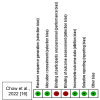Long-Term Cardiovascular Outcomes in Childhood Cancer Survivors: A Systematic Review
- PMID: 40642705
- PMCID: PMC12241830
- DOI: 10.7759/cureus.85670
Long-Term Cardiovascular Outcomes in Childhood Cancer Survivors: A Systematic Review
Abstract
In recent years, childhood cancer appears to have become more common. Cardiovascular (CV) diseases have been cited as the leading cause of noncancer mortality among childhood cancer survivors. This systematic review evaluated the long-term CV outcomes of childhood cancer survivors. Eleven studies, published between 2015 and 2024 that satisfied the criteria for a thorough assessment, are included in the study. The research found consistent associations between specific cancer treatments, such as anthracyclines, radiation therapy, and total body irradiation, and increased risks of cardiomyopathy, coronary artery disease, and metabolic syndrome. Hematological malignancies, such as childhood acute lymphoblastic leukemia, and survivors of solid tumors like prostate and lung cancers were more specifically associated with CV complications. Although factors like obesity, hypertension, and insulin resistance were commonly reported, discrepancies based on race and gender were diverse across studies. Case in point, cardiometabolic challenges were more prevalent among non-Hispanic Black and Hispanic survivors, but these patterns were not uniform in all cohorts. Comparably, vulnerabilities such as peripartum cardiomyopathy were more evident in female survivors, particularly at younger ages and with higher anthracycline doses. These findings underscore both consistent and variable patterns of CV risks among childhood cancer survivors. The threats are influenced by the kind of cancer, the type of therapy, and demographic factors such as age, gender, and ethnicity. Thus, there is a need to put in place systematic, lifelong programs for cardiometabolic screening and risk reduction that are tailored to each person's risk profile. These programs should include echocardiography, regular serum biomarker testing, lifestyle modifications (exercise, nutrition), and psychosocial support.
Keywords: ambulatory blood pressure monitoring; cardiovascular disease; cardiovascular risk factors (cvrf); graft-versus-host disease; hematopoietic stem cell transplantation (hsct).
Copyright © 2025, Fahmi et al.
Conflict of interest statement
Conflicts of interest: In compliance with the ICMJE uniform disclosure form, all authors declare the following: Payment/services info: All authors have declared that no financial support was received from any organization for the submitted work. Financial relationships: All authors have declared that they have no financial relationships at present or within the previous three years with any organizations that might have an interest in the submitted work. Other relationships: All authors have declared that there are no other relationships or activities that could appear to have influenced the submitted work.
Figures




Similar articles
-
Nutritional interventions for survivors of childhood cancer.Cochrane Database Syst Rev. 2016 Aug 22;2016(8):CD009678. doi: 10.1002/14651858.CD009678.pub2. Cochrane Database Syst Rev. 2016. PMID: 27545902 Free PMC article.
-
The Black Book of Psychotropic Dosing and Monitoring.Psychopharmacol Bull. 2024 Jul 8;54(3):8-59. Psychopharmacol Bull. 2024. PMID: 38993656 Free PMC article. Review.
-
Maternal and neonatal outcomes of elective induction of labor.Evid Rep Technol Assess (Full Rep). 2009 Mar;(176):1-257. Evid Rep Technol Assess (Full Rep). 2009. PMID: 19408970 Free PMC article.
-
A rapid and systematic review of the clinical effectiveness and cost-effectiveness of paclitaxel, docetaxel, gemcitabine and vinorelbine in non-small-cell lung cancer.Health Technol Assess. 2001;5(32):1-195. doi: 10.3310/hta5320. Health Technol Assess. 2001. PMID: 12065068
-
Physical exercise training interventions for children and young adults during and after treatment for childhood cancer.Cochrane Database Syst Rev. 2016 Mar 31;3(3):CD008796. doi: 10.1002/14651858.CD008796.pub3. Cochrane Database Syst Rev. 2016. PMID: 27030386 Free PMC article.
References
Publication types
LinkOut - more resources
Full Text Sources
